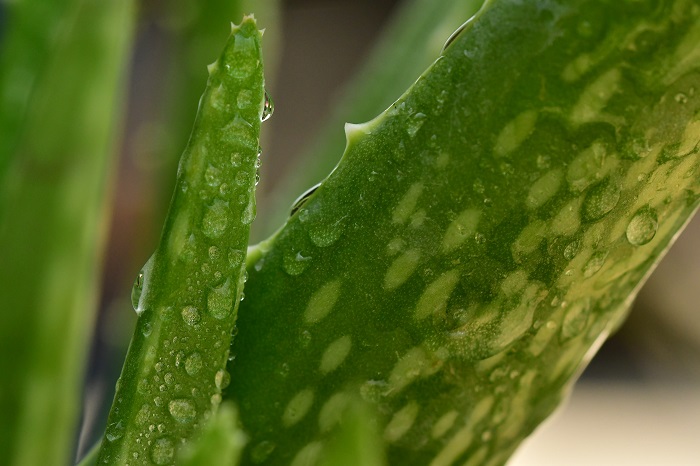
Aloe vera juice represents a powerful source of nutrition. Because of its anti-inflammatory properties and soothing qualities, the liquid can be used in various health and beauty products. Whether you use the juice directly from the plant or buy it online, you will find that this liquid is your one go-to source for health, beauty, and medical care.
Aloe vera, used for thousands of years, can grow outside, as long as the frost has ended and it is pleasantly warm. You can place potted plants outside where you live after the year’s last frost has come and gone. Always use sandy soil and extract liquid from mature leaves only. Aloe vera plants are considered mature around three or four years old. The health, beauty, and medical benefits associated with the plant make it the ideal choice for plant lovers as well as people who want to enjoy aloe’s many health and beauty benefits.
Some of the Major Benefits of Drinking Aloe Vera Juice
You can find a great deal of use from aloe vera’s liquid. Below is a sampling of some of the benefits.
1. Aloe vera’s liquid is full of vitamins and minerals, and similar nutritional components
Aloe vera contains a large number of vitamins and minerals. Vitamins include A, C, E, and the B vitamins of B1, B2, B3, B6, and B12. While vitamin A is helpful for building a strong immune system and enhancing bone growth, vitamin C protects against cardiovascular disease and cancer. In addition, vitamin A wards off bacterial or viral threats.
Vitamin E promotes a strong immune system, and protects against heart problems. The B1 vitamin is also known as thiamin. It aids in digestion and contributes to a healthier immune system while healing any nerve damage. B2, which is also known as riboflavin, is an antioxidant. It provides energy to the body by converting food to fuel. This vitamin contributes to enhanced neural health.
Vitamin B3, also called niacin, treats migraines, diabetes, and high cholesterol. It cleanses the body of toxins, promoting good digestive health. B6, which is linked to the dopamine and serotonin processes, aids in many areas, and enhances digestive, cardiovascular, and immune system health. Vitamin B12, in aloe vera, is found mainly in animal products. It aids in the manufacture of DNA and supports the blood cells.
The minerals in aloe vera, just like the vitamins, are numerous. For example, the liquid contains calcium, known for building strong teeth and bones. Sodium is another nutritional ingredient, known for regulating the blood pressure and contributing to better muscular and nervous system health. Iron is used for energy while magnesium influences blood glucose counts and immune system functioning.
The potassium found in aloe vera protects the blood vessels and lowers heart disease risk. Copper, which is found in the juice, helps in the prevention of osteoporosis. It also contributes to a person’s hearth health.
Aloe vera contains 12 anthraquinones, or organic compounds. For instance, one of the anthraquinones, emodin, provides pain relief and fights harmful viruses and bacteria. In commercial aloe products, anthraquinones are usually removed.
Polysaccharides can be found in aloe vera liquid as well. One noted polysaccharide or sugar is called acemannan. This sugar fights viruses, eases digestive distress, and stimulates immune system functioning. The liquid also supports immune health with plant-based fatty acids. These acids have been shown to contain antiseptic and anti-inflammatory attributes. The acids reduce pain as well.
According to the National Institutes of Health (NIH), aloe vera contains as many as 20 amino acids, seven of which are considered essential to one’s health and well-being. The plant contains hormones that support wound healing as well as eight essential enzymes.
2. Aloe vera is a top digestive aid
As a digestive aid, aloe has been proven to help with ulcers, detoxify the digestive tract, and relieve irritable bowel syndrome (IBS). Because it is soothing, aloe vera gently aids in the health of mucosal tissues in the digestive tract. Kelly Morrow, who is a faculty member and clinical supervisor at Bastyr University, has used the gel of the plant to ease stomach irritations in patients receiving radiation treatments and chemotherapy.
3. Drinking the liquid strengthens the immune system
The ability of aloe to detoxify helps users keep their immune systems healthy. The body has a greater chance to fight off sickness or infection when lots of nutrients enter the body. The prime components of aloe vera gel, polysaccharides, support immune system health.
These same ingredients can also irritate immune functioning, but not in a bad way. Instead, the ingredients strength the immune system, which perceives them as a threat. The antioxidants in aloe vera gels and liquids also prevent attacks from free radicals, which negatively impact immune health.
4. The juice lowers cholesterol readings
Studies show that aloe can reduce cholesterol readings. Researchers at the National Institutes of Health (NIH) report that a daily ingestion of 15 ml of aloe for a three-month period reduced LDL or bad cholesterol by approximately 18% and total cholesterol by as much as 15%.
5. Aloe liquids relieve pain
The anti-inflammatory and analgesic properties of aloe lessen tendon and muscle discomfort. That is why the gel is sometimes used in the field of sports medicine to relieve aching muscles. When taken orally, the juice will reduce chronic pain. If you drink aloe vera juice to manage pain, you also need to reformat your diet. The liquid works better if you stop eating junk or processed foods and make healthier substitutions.
6. Drinking the juice regularly aids in diabetic health
People who have been diagnosed with Type 2 diabetes can drink aloe juice to reduce excess blood fats. The liquid also heals wounds effectively – something that is useful for diabetics who suffer from ulcers or open wounds on the legs.
However, check with you doctor before drinking the juice. Never consume the juice with a glucose-lowering medicine, as doing so can be harmful. Because aloe vera lowers glucose levels as well, you can get too much of a good thing.
7. Consumption of the liquid relieves arthritic pains
Arthritis can be relieved by drinking aloe vera juice. The liquid contains amino acids and enzymes, known for their anti-inflammatory qualities. Because arthritis causes joint inflammation and pain, aloe vera can be consumed in a juice for easing arthritis pain and suffering.
8. Aloe vera juice can also be used in a variety of topical applications
Because of its nutritional compounds, aloe vera can be drank, but also applied topically. Use the gel or liquid for conditioning the hair, reducing skin irritations, and treating a skin disease, such as psoriasis. You can also use the gel or liquid to lighten hyperpigmentation and keep the skin firmer and more vibrant. Use it as a lip treatment and moisturizer, as well as a balm for chapped or cracked lips.
The Use of Aloe Vera in Creams and Soaps: How to Find the Perfect Recipe
Hydrating the Skin with Aloe Vera
2 Aloe Vera Juice Recipes for Topical Use and Drinking
1. Cucumber Eye and Facial Gel
You can use the gel or juice of aloe vera to produce a gel or moisturizer for the eye area and the face. Take the gel from one leaf and mix with one small chopped cucumber. Add1/2 cup distilled extract of witch hazel and one pack of gelatin. Include one white teabag and three drops of peppermint essential oil.
Directions:
1. Peel and slice the aloe leaf to extract the gel – wash off the latex on gel, which is yellowish in color. The latex can trigger stomach cramps or can make people very sick. Therefore, remember the color as a caution – and always clean off any yellowish residue.
2. Place the gel and cucumber into a food processor or blender until it is smooth.
3. Strain the mix through a sieve so you can obtain the liquid. Set aside 1/2 cup of the juice.
4. Into a small pan, add the witch hazel before whisking the gelatin and including the teabag. Heat the mix until it begins to thicken.
5. As the substance cools, remove the teabag, whisking in the aloe juice and cucumber mixture, before sprinkling the peppermint oil.
6. Pour the aloe vera juice into an airtight dispenser with a pump.
Preparing a Digestive Drink Using Aloe Vera Juice
You can also enjoy aloe vera’s benefits in a smoothie. The following recipe will help you do just that. In this case, the smoothie is designed to support digestive health.
2. Daily Digestive – Aloe Vera Juice Smoothie Recipe
This helpful digestive soother yields about two servings of a smoothie, and can be prepared in about ten minutes. You will need to gather the following ingredients:
- 2 ounces of aloe vera juice
- 1 cup of frozen pineapple chunks
- 1/2 cup of plain yogurt
- 1/2 cup frozen banana slices
- 1 cup spinach
- 1/2 cup cinnamon (in powder form)
- 1/2 cup water
One you have collected all the ingredients, this is a quick recipe to make. Just place the above-listed ingredients into a blender or food processor, and blend on a high speed. Once the mixture is a smooth consistency, serve it for drinking immediately.
Some additional smoothie tips –
Add a sprinkle of cinnamon on top of the drink concoction to give it a flavor boost.
Use coconut water instead of real water to enjoy an enhanced flavor and receive the nutritional benefit of electrolytes.
You can modify this recipe by replacing the banana slices and pineapple chunks with lemon slices or watermelon cubes. Add 1-1/2 cups watermelon or lemon pulp in the processor or blender. Do not add the cinnamon. Including watermelon or lemon supports detoxification.
Enjoy Better Health and Improve your Appearance Naturally and Economically
Once you start using aloe vera juice for consumption or topical use, you will see a marked improvement in your general health, including the way you look and feel. The nutritional benefits associated with aloe vera gels and juices make their application and consumption both practical and cost-effective.
